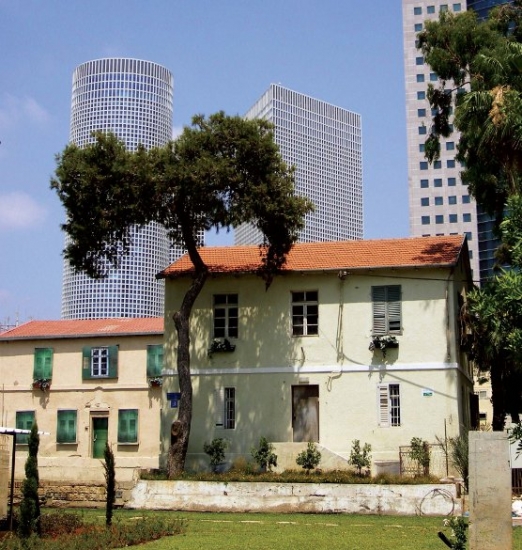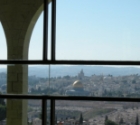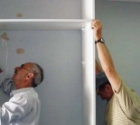
An area of Tel Aviv that was in the past an agricultural colony set up by a German Christian sect in 1871 has been renovated as part of the city's centenary celebrations.
The Sarona Gardens renovation is an extremely ambitious project that, apart from renovating the dilapidated buildings, also involved physically moving some of the Templer sect's former homes and workshops in order to widen Kaplan Street running between the Sarona and the extensive Israel Defense Forces headquarters across the way.
The phenomenal facelift planned and executed by master craftsmen on the former two-story Templer colony red-roofed stone buildings is shown off to the hilt by the surrounding ultramodern glass fronted high-rise edifices of the new millennium – including the Azrieli towers.
Guided tours of Sarona are becoming popular with locals and Israelis from far and wide as well as overseas visitors who have begun to visit a part of the city that was definitely off the tourists beaten track until recently.
The Templer sect members built colonies in Haifa, Bethlehem HaGlilit and Waldheim in the Jezreel Valley as well as in Tel Aviv and elsewhere.
Not all the few dozens of buildings have been entirely renovated, some just outwardly spruced up in the meantime as the project moves forward. Eventually plans are for the area to be super-trendy with upscale everything to attract folks to spend leisure time in Sarona – as well as catering to the curiosity of visitors wanting to know more in-depth history of the colony, those who built it and the treasure of exciting discoveries uncovered once the renovations got under way.
The Templer Christians broke away from the Protestant Church in Germany under the leadership of a theologian named Christoph Hoffman, whose agenda included the creation of a new nation with a rectified social order. The first group arrived in Palestine to prepare for the coming of the Messiah in the late 1860s, initially settling in Haifa.
During the First World War they were expelled for a while by the British, being as they were seen as allies of the Turks, but most returned to Palestine from exile in Egypt when the British changed their minds about Templer banishment from the Holy Land.
The Templers proved to be decidedly pro-Nazi sending some of their youth to meet with leaders of the Nazi party in Germany. With the advent of World War 11 the sect was again rounded up by the British and given a choice, either to return to Germany or go to Australia. The majority of the community in Palestine at that time was made up of women and children as many of the men had returned to Germany to enlist in the army.
Back to present times and the moving of the Templer-built houses in Sarona. The intricate operation to move the buildings was undertaken by Solel Boneh, an Israeli company, and a Dutch company specializing in the transfer of buildings.
Whilst the Dutchmen were working on the project they were amazed to discover more than a professional connection to the Templer community, once told of an incident involving the rescue in 1944 of 222 Dutch Jews imprisoned in Bergen-Belsen by the Germans and snatched from the jaws of a cruel death in an exchange for Templers detained in Palestine by the British Mandatory Forces.
Apparently, members of the sect who had returned to Germany had approached Himmler with the idea of exchanging the Jews for their family members held in detention in Palestine.
A Yad Vashem publication dealing with that and other exchanges was the subject of a symposium held in Jerusalem a few decades back. Historian Ruth Zariz writes in “From Bergen-Belsen to Freedom” that it had become known both to Himmler and groups in the German Foreign Office that there had been thoughts of a large scale exchange bandied about. At that time they were of the opinion that it would be possible to exchange a large number of Jews and others for German citizens living at that time in Palestine and countries of the British Empire.
"They therefore planned on a reservoir of 30,000 candidates for exchange from Bergen-Belsen," writes Zariz.
She also quotes from a letter written in May, 1943 by Von Thadden, a staff member of a department of the foreign ministry and in charge of exchanges.
"As there are more Germans in British hands than British in German hands, in this special case the Jews can also be exchanged," and later on, writes, "as the German citizens of Palestine were transferred to Australia, we should keep Jewish children from the western countries for purposes of exchange."
With the outbreak of World War 11, the Sarona neighborhood was taken over by the British Mandate Custodian of Enemy Property and a few weeks before the British Mandatory Forces pulled out of the country, sold Sarona to the Tel Aviv municipality.
In recent years The Society for the Preservation of Historical Sites waged war with the IDF when the latter was planning to demolish the Templers’ homes – the first houses in the country by the way to be built with attics, created by the people accredited with technologically advancing not just their own communities but those of the Zionist movement as well.
The Templer sect in the Holy Land is indeed a story full of contradictions.
 The Morman University Sunday Concert, with ESRA
The Morman University Sunday Concert, with ESRA  Congratulations to ESRA Rehovot on its 10th
Congratulations to ESRA Rehovot on its 10th  THANK YOU!
THANK YOU! A new website in English - on Volunteering - Launched in Israel
A new website in English - on Volunteering - Launched in Israel Help Needed for Abused Horses and Donkeys
Help Needed for Abused Horses and Donkeys Heather's Heseg
Heather's Heseg Lydia Aisenberg
Lydia Aisenberg